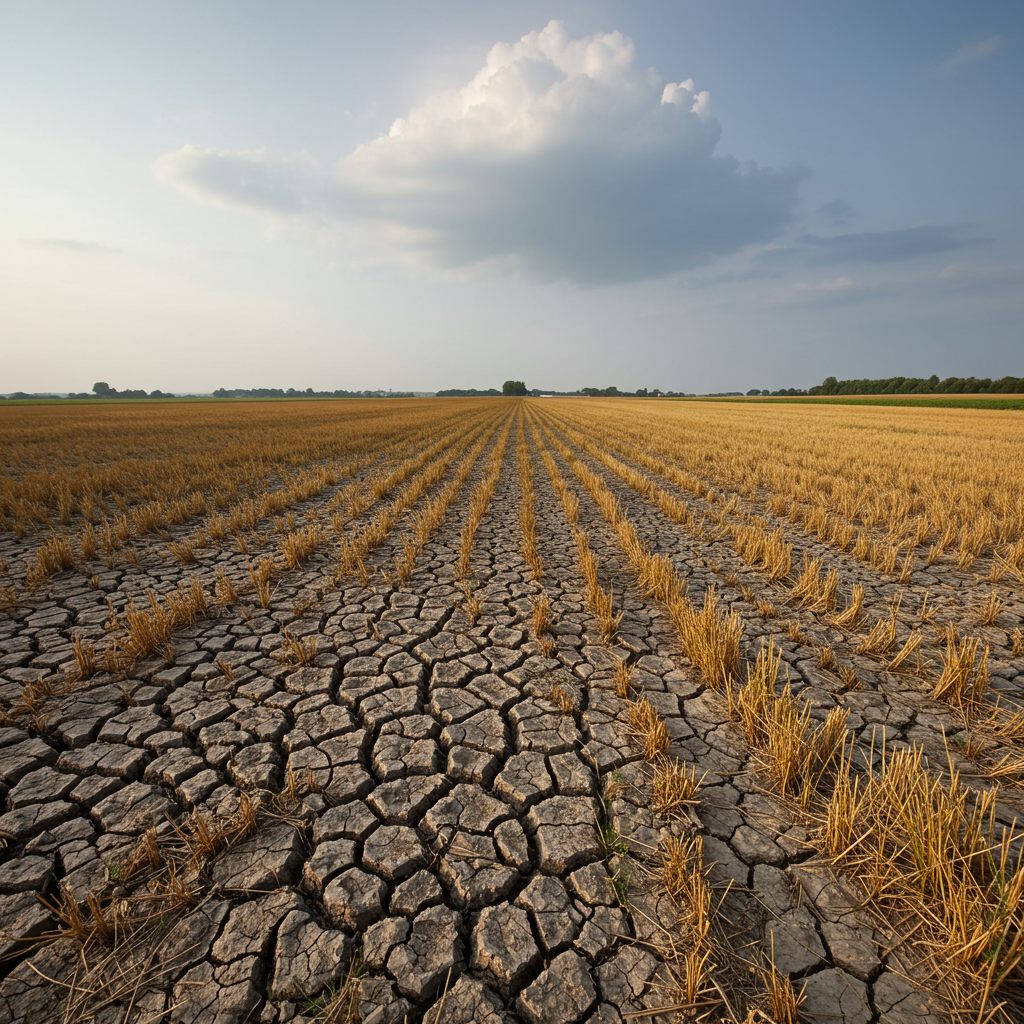A blistering, record-breaking heatwave is currently overwhelming large parts of Europe, triggering unprecedented emergency alerts and pushing temperatures into dangerous territory. Southern and eastern regions are experiencing the most intense conditions. This extreme weather event poses significant health risks and challenges essential infrastructure across the continent. Experts confirm this heatwave is amplified by human-caused climate change, highlighting the urgent need for adaptation.
Europe Reels Under “Unprecedented” Heat
France stands at the epicenter of this intense heatwave. Authorities issued a record number of heat alerts across the nation. Sixteen French regions, including the capital Paris, were placed under the highest level, a ‘red alert’, on Tuesday. An additional 68 regions received an ‘orange alert’. On Monday, 84 out of 96 mainland regions were already under an orange alert. France’s Climate Minister, Agnès Pannier-Runacher, described the situation as “unprecedented”.
The extreme heat has forced practical responses. Nearly 200 schools throughout France have been closed or are operating under partial closure. This heatwave has impacted parts of Europe for over a week and is expected to peak mid-week. Red alerts in France officially took effect at noon local time on Tuesday.
Wildfires represent another dangerous consequence. Several fires ignited in the southern Corbières mountain range on Sunday. These blazes led to evacuations and temporarily closed a motorway. Officials confirmed to French media that firefighters have since contained these fires. Some areas, like the Corbières region, even opened air-conditioned municipal buildings as temporary refuges for residents seeking relief.
Iberian Peninsula: Setting New Records
Spain and Portugal are experiencing particularly punishing temperatures. Both nations provisionally recorded their hottest June days on record over the weekend. El Granado in Andalucía, Spain, registered a scorching 46C (114.8F) on Saturday. This surpassed Spain’s previous June record of 45.2C set in Seville back in 1965. On Sunday, the town of Mora in central Portugal recorded an even higher temperature of 46.6C (115.9F).
Spain appears on track to log its hottest June ever. For many residents, this heat makes normal life incredibly difficult. Anabel Sanchez, 21, shared her experience in Seville with Reuters. “I can’t sleep well and have insomnia,” she said. “I also get heat strokes, I stop eating and I just can’t focus.” Portugal faces a similar struggle. Seven districts, including the capital, Lisbon, are currently under the nation’s highest alert level. Residents report a lack of air conditioning in many homes and on public transport, making it hard to function and causing uncomfortable nights where temperatures fail to drop below 26-31C (79-88F). In Seville, the state rail company Renfe was seen providing fans to passengers attempting to cope with the conditions.
Italy, Germany, and the Balkans Face Rising Heat
Italy is also grappling with severe heat. Twenty-one Italian cities are currently on the highest alert level, including major centers like Rome, Milan, and Venice. The island of Sardinia is also under the highest alert. The impact on public health is becoming evident. Mario Guarino, vice-president of the Italian Society of Emergency Medicine, told AFP news agency that hospital emergency departments nationwide had seen a 10% rise in cases related to heatstroke.
Germany and Austria are bracing for extreme heat later this week. Germany’s meteorological service warned temperatures could reach almost 38C (100.4F) on Tuesday and Wednesday. This forecast includes potentially record-breaking temperatures for the region. The intense heat is already affecting vital infrastructure. Lowered water levels in the Rhine River, a crucial shipping route, are limiting cargo capacity for vessels. This directly translates into increased freighting costs for goods moved along the river. Vienna is expecting temperatures above 38C, a trend described as a “new normal” for the summer months.
Countries across the Balkans have also struggled with the extreme temperatures. While some areas are seeing slight cooling, others remain under severe warnings. Wildfires are a significant concern in this region. Croatia has red heat warnings in place for its coastal areas, and firefighters have battled blazes. An extreme temperature alert was issued for neighboring Montenegro. Serbia reported its hottest day on record on Wednesday and is experiencing “severe and extreme drought conditions” in much of the country. Bosnia and Herzegovina’s capital, Sarajevo, recorded a record 38.8C (101.8F) on Thursday. Slovenia logged its hottest-ever June temperature on Saturday. North Macedonia’s capital, Skopje, reached 42C (107.6F) on Friday, with similar temperatures expected to persist.
Further south, Turkey has faced hundreds of wildfires fueled by strong winds, some reaching 120km/h (75 mph). Rescuers evacuated over 50,000 people, primarily from the resort city of Izmir in western Turkey. These fires have destroyed at least 20 homes. Coastal regions in Turkey have seen an increase in wildfires in recent years due to hotter, drier summers, a trend scientists link to human-induced climate change.
UK Experiences Near-Records and Daily Disruption
The heatwave has also extended its reach to the UK, particularly England and Wales. Temperatures soared on Monday, nearly reaching previous June records. The highest UK temperature recorded that day was 33.1C (91.6F) at Heathrow Airport in London. Other notable high temperatures included 33C at St James’s Park and 32.9C at Kew. Wimbledon also recorded 32.9C, marking the tennis tournament’s hottest opening day on record.
The heat prompted health warnings. The UK Health Security Agency extended heat health alerts across England. Amber alerts, signifying significant health risks for vulnerable populations, cover vast regions including London, the South East, South West, East of England, East Midlands, West Midlands, and Yorkshire and the Humber, remaining in effect until Wednesday morning. A yellow alert was also extended for the North West. These alerts guide public behavior and inform actions for NHS England and healthcare professionals. Forecasts suggested the heat could peak again in the far South East on Tuesday, potentially reaching 34-35C (93-95F), before cooler air arrives nationwide by Wednesday.
The high temperatures have caused widespread disruption. Train services have been affected due to heat-related issues like points failures and the need for emergency speed restrictions on vulnerable tracks. In South London, a fault on a Thameslink train exacerbated problems, halting services and stranding passengers for hours without power or air conditioning on trains outside stations near Loughborough Junction. Passengers were evacuated trackside, with some reporting missed flights from Gatwick due to the significant delays.
The heat also raises serious public health concerns. Researchers from the London School of Hygiene and Tropical Medicine and Imperial College London estimated potential excess deaths linked to the heatwave. Their analysis suggested London could see 129 excess deaths this week, and approximately 570 across England and Wales from Thursday to Sunday. Dr. Garyfallos Konstantinoudis from ICL described extreme heat as an “underappreciated threat” and a “silent killer” that contributes significantly to mortality, especially for those with pre-existing conditions, even if not listed as a direct cause. The London Ambulance Service reported a notable surge in calls, receiving 7,000 calls on a day temperatures hit 28C, compared to a typical busy day’s 5,500. They activated plans to manage this demand and urged the public to use emergency services only for life-threatening situations and to check on vulnerable neighbors. NHS urgent care doctors also reported a rise in heat-related illnesses like heat exhaustion.
Water safety becomes critical during hot weather. The London Fire Brigade highlighted the dangers of cooling off in open water, reporting 15 deaths in London’s waterways this year and a 15% increase in water rescue callouts. They warned people about hidden dangers and urged reconsideration before jumping in. Wildfires are also a risk, particularly in Scotland, with fires reported in the Highlands and Aberdeenshire, requiring fire crews to work through the night and leading to road closures.
The phenomenon of the Urban Heat Island Effect makes cities significantly warmer than surrounding rural areas during heatwaves, sometimes by 4-10C. This is because hard surfaces absorb and retain heat, releasing it slowly, especially at night, while waste heat from human activity also contributes.
Environmental Strains and the Climate Link
Beyond direct human impacts, the heatwave is stressing Europe’s environment. Higher temperatures in the Adriatic Sea are encouraging invasive species, such as the poisonous lionfish, to spread. Alpine glaciers, already shrinking at alarming rates, face further stress from the prolonged heat. Drought conditions are intensifying in countries like Serbia.
Wildfires raging across Europe and Turkey are linked to specific weather patterns amplified by heat. Experts refer to “fire weather,” a combination of heat, drought, and strong wind, which is increasing globally. Human-caused climate breakdown contributes to a higher likelihood of fires and larger burned areas in regions like southern Europe, increasing the average wildfire season length globally by about two weeks.
This intense heatwave underscores the reality of climate change. Volker Turk, the UN’s human rights chief, stated that the heatwave highlights the urgent need for climate adaptation. This includes transitioning away from practices and energy sources, like fossil fuels, which are the primary drivers of climate change. Rising temperatures, sea levels, floods, droughts, and wildfires threaten fundamental human rights, including the rights to life and health.
The UN’s Intergovernmental Panel on Climate Change (IPCC) confirms that human-caused climate change is making heatwaves more common and more intense. As the planet warms due to rising greenhouse gas levels trapping excess heat, explained Professor Richard Allan of the University of Reading, heatwaves are intensifying. The atmosphere becomes warmer and drier, drying out soils more effectively, turning moderate heat events into extreme ones. Analysis by the World Weather Attribution group suggests heatwave conditions like three consecutive days above 28C in parts of southeast England are now approximately 10 times more likely than before significant human warming of the planet occurred. This heatwave aligns with the “new normal” increasingly predicted by climate scientists.
Staying Safe During Extreme Heat
Authorities across Europe are urging citizens to take precautions. Emergency medical services remain on standby in many countries. The general advice is to stay indoors as much as possible, especially during the hottest parts of the day (typically 11 am to 3 pm).
Practical Tips for Coping with Heat
Stay Hydrated: Drink plenty of water throughout the day, even if you don’t feel thirsty. Avoid excessive alcohol and caffeine.
Eat Smart: Consume foods with high water content, such as fruits and vegetables.
Dress Appropriately: Wear loose, light-colored, breathable clothing.
Seek Shade: Stay in the shade whenever possible. Use hats and sunglasses outdoors.
Cool Down: Take cool showers or baths. Use fans, ice packs, or damp cloths.
Ventilate: Keep windows closed during the day when it’s hotter outside. Open them at night when temperatures drop.
Check on Others: Look out for vulnerable people, such as the elderly, very young children, and those with underlying health conditions. Ensure they are staying cool and hydrated.
Pets: Limit walks to early morning or late evening. Provide cooling mats, frozen treats, and plenty of fresh water. Be especially mindful of older pets and flat-faced breeds.
Diabetes Management: Frequently check blood sugar levels. Protect meters and test strips from heat. Shield technology like continuous glucose monitors and insulin pumps from direct sun. Store insulin properly (check manufacturer guidelines). Stay well-hydrated.
Water Safety: Be aware of the hidden dangers beneath the surface of open water if you plan to swim. Cold water shock and unseen obstacles can be fatal.
Frequently Asked Questions
Why are these heatwaves happening and called “unprecedented”?
Extreme heatwaves like this one are becoming more frequent and intense primarily due to human-caused climate change. Greenhouse gases from burning fossil fuels trap heat in the atmosphere, warming the planet. Scientists confirm this warming makes heatwaves more likely and severe. The term “unprecedented” is used by authorities, like the French Climate Minister, because the scale of alerts and records being broken across so many regions simultaneously is historically unmatched for this time of year, representing a departure from past climate norms.
Which European countries are most affected by the current heatwave and what kinds of alerts are in place?
Many European countries are affected, with the most severe conditions currently gripping southern and eastern parts. France has implemented its highest ‘red’ heat alerts in 16 regions, along with widespread ‘orange’ alerts. Italy has 21 cities on the highest alert level. Spain and Portugal have recorded their hottest June days ever and have high alert levels. The UK has issued ‘Amber’ and ‘Yellow’ heat health alerts across much of England. Countries in the Balkans like Croatia and Montenegro also have red or extreme temperature warnings in coastal areas, while Serbia faces drought and recorded its hottest day.
What are the main health risks and practical safety tips during this extreme European heatwave?
The primary health risks include heat exhaustion, heatstroke, and for vulnerable individuals or those with pre-existing conditions, a potential increase in mortality (excess deaths). Hospital emergency departments are seeing more heatstroke cases. Emergency medical services are on high alert. To stay safe, it’s crucial to stay hydrated by drinking lots of water, seek shade, wear light clothing, take cool showers, and avoid strenuous activity during the hottest parts of the day. Check on elderly neighbors and ensure children and pets are also kept cool and hydrated. Be cautious around water bodies due to increased drowning risks.
The widespread impact of this heatwave serves as a stark reminder of the increasing frequency and intensity of extreme weather events in a changing climate. Protecting public health, supporting infrastructure, and adapting to these new climate realities are critical challenges facing Europe and the world.



